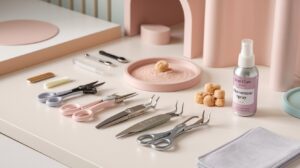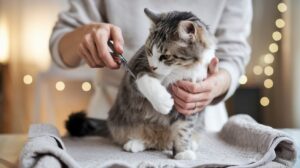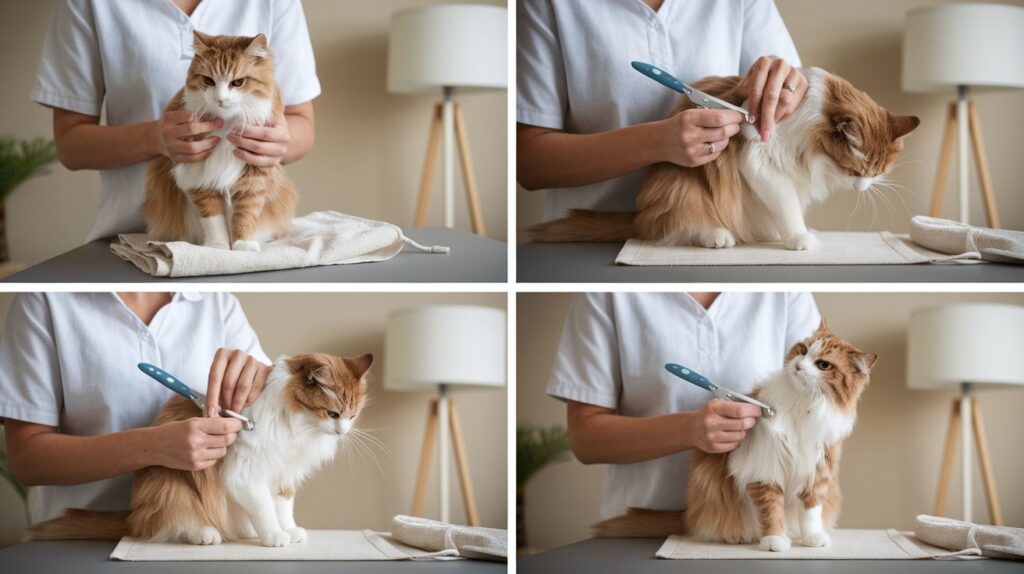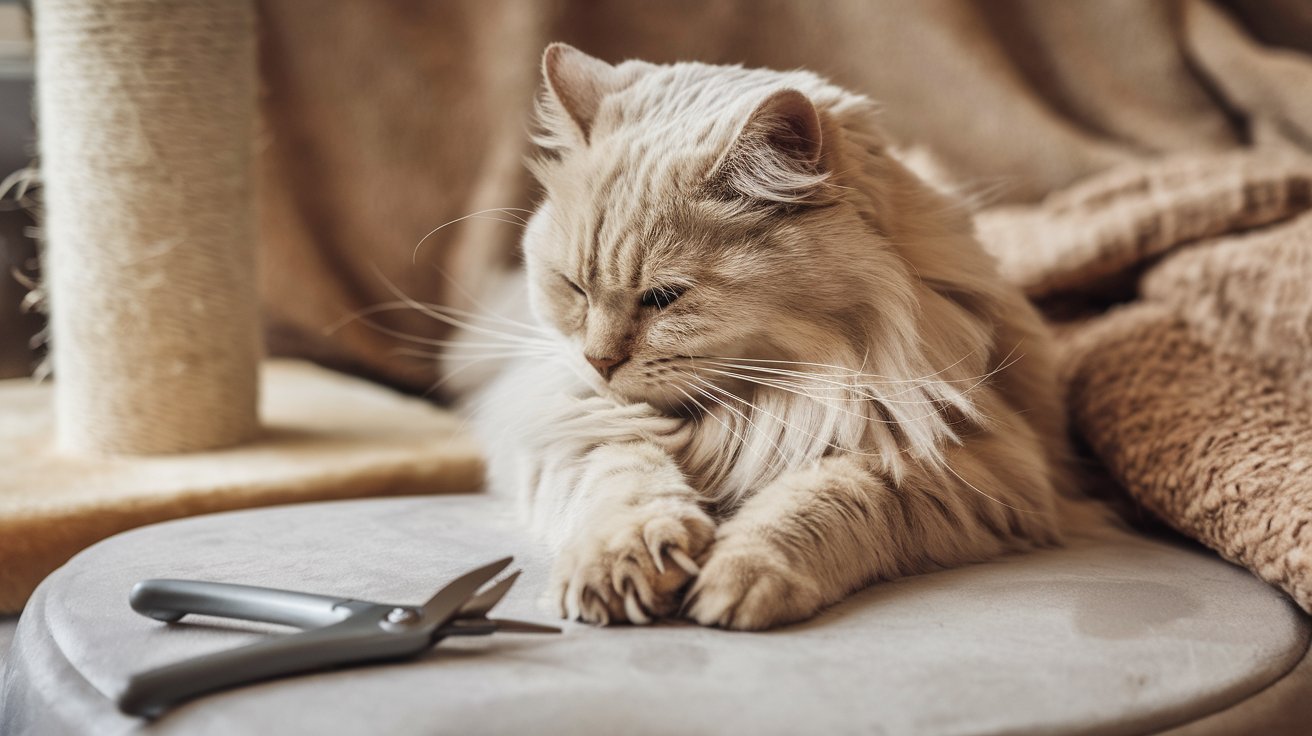Introduction
Knowing How to Trim Your Cats Back Claws is an essential part of keeping your feline healthy and happy. While front claws often get the most attention, back claws play an equally important role in a cat’s overall well-being. Regular trimming not only keeps your furniture safe but also prevents overgrown claws from causing discomfort or injury to your cat. Learning the proper technique and understanding why this task is crucial will help you and your pet feel more at ease.
Many cat owners overlook the back claws, assuming they don’t need as much care. However, just like the front claws, these can grow too long, curl, and even embed themselves into the paw pad, leading to pain and infections. That’s why regular claw maintenance, including trimming the back claws, should be part of your pet care routine.
Importance of Claw Care for Cats
Claw care is crucial for your cat’s health and behavior, impacting their balance, climbing, and self-defense. Long claws can lead to mobility issues and accidents, as they may snag on carpets or furniture. Neglected claws can cause limping, joint pain, or infections in the nail beds. Indoor cats, in particular, may not wear down their claws naturally, making regular trimming essential to prevent overgrowth and discomfort.
Why Back Claws Need Attention Too
Back claws are as important as front claws but often get overlooked. They grow more slowly but can still become overgrown, curling into the paw pads and causing discomfort or injury. This can lead to infections and hinder your cat’s ability to climb or jump. Keeping back claws trimmed ensures your cat’s mobility and safety, whether they’re indoors or outdoors.
A Veterinarian and Pet Owner’s Perspective
Both veterinarians and pet owners agree that regular claw trimming is vital. Vets recommend starting claw care early to reduce stress and prevent future problems. For pet owners, trimming is a bonding opportunity. With the right tools and a calm environment, trimming becomes easier. Patience and positive reinforcement can help your cat adjust, ensuring their comfort and long-term health.
Understanding Cat Claws
Cats’ claws are multifunctional, aiding in balance, hunting, and self-defense. They grow in layers, shedding the outer parts naturally. Indoor cats may not wear down their claws effectively, so regular trimming is necessary to prevent overgrowth and discomfort. Claws are retractable, allowing cats to walk quietly, which is important for their survival instincts.
Anatomy of a Cat’s Claws: Front vs. Back Claws
Front claws are sharper, used for scratching and climbing, and tend to grow faster due to more frequent use. Back claws, though less involved in scratching, are essential for balance and grip. They grow more slowly but still need regular attention to prevent overgrowth and discomfort.
Why Cats’ Claws Grow Continuously
Cats’ claws grow continuously to ensure they remain sharp for hunting and climbing. The claws are made of keratin and naturally renew themselves. While outdoor cats naturally wear down their claws, indoor cats may need regular trimming to prevent overgrowth and injury.
Natural Methods Cats Use to Wear Down Their Claws (Scratching, Outdoor Activity)
Cats in the wild naturally destroy their claws through clawing, climbing, and stomping on uneven ground. Indoor cats need scratching posts and textured surfaces to mimic this natural behavior. Despite these tools, indoor cats may require regular trimming to keep their claws at a healthy length.
Why You Should Trim Your Cat’s Back Claws
Trimming back claws is crucial for preventing injuries and protecting your home. Overgrown claws can snag on fabrics, cause scratches, and damage furniture. Regular trimming also prevents painful conditions like overgrowth and ingrown claws, ensuring your cat’s comfort and proper posture.
When Should You Trim Your Cat’s Claws?
Trim your cat’s claws every 2 to 4 weeks, depending on their activity level and environment. Indoor cats may need more frequent trimming than outdoor cats. Signs that claws need trimming include clicking noises on hard surfaces and snagging on fabrics. Seasonal activity changes can also impact trimming frequency.
Tools You’ll Need
Having the right tools is essential for safely and effectively trimming your cat’s claws. There are several types of claw trimmers available, and it’s important to choose the one that suits you and your cat. Scissor clippers are widely used and include a mechanism similar to a scissor that makes cutting simple. Guillotine clippers, which have a hole where you insert the claw before pressing down, are another option and provide a clean cut, but they require precise placement. Some cat owners also use human nail clippers for smaller cats or kittens, but specialized pet tools tend to give better results.

The size and type of the trimmer you choose are crucial for the health and comfort of your cat. If the tool is too large or heavy, it can be difficult to control, increasing the risk of accidentally cutting too much of the claw or injuring the quick (the sensitive part of the nail). Choosing a trimmer that’s the right size ensures better accuracy and reduces the chance of injury. Additionally, dull blades can crush rather than cleanly cut the claw, leading to discomfort for your cat, so regularly check and replace blades when necessary.
In addition to the trimmer, having other supplies on hand can make the process smoother. Styptic powder is a must in case you accidentally cut the quick, as it helps stop any bleeding immediately. Offering your cat treats after trimming can make the experience more positive, and over time, they may associate the process with a reward. If your cat is particularly anxious, using calming aids like pheromone sprays or calming treats can help them stay relaxed during the trimming session.
How to Prepare Your Cat
Before trimming your cat’s claws, it’s important to gain their trust and help them feel comfortable with the process. Start by gently handling your cat’s paws regularly, so they become accustomed to the sensation. You can begin by petting your cat while they’re relaxed, slowly working your way to touching their paws. When you hold their paw, lightly press on the pad to extend the claws, then release. Doing this daily will help your cat get used to having their paws touched without feeling threatened.
The secret to keeping your cat calm and cooperative during the trimming procedure is to introduce it gradually. To begin, replicate their trimming motions without actually cutting their claws. With the trimmers held close to their paws, softly tap the clippers on the nails without cutting them, and press on the pad to reveal the claws. This mock trimming will allow your cat to associate the tools with a non-threatening activity. Over time, your cat will become more comfortable, and you can proceed with trimming a single claw at a time before attempting more.

Creating a calm environment is also critical for reducing stress during claw trimming. Choose a quiet time when your cat is naturally relaxed, such as after a meal or a play session. Avoid trimming when your cat is energetic or agitated. Calming sprays, like feline pheromone diffusers, or soothing music can help create a peaceful atmosphere. If your cat becomes too anxious, don’t rush the process—take breaks, and reward them with treats or affection to reinforce positive behavior.
Step-by-Step Guide to Trimming Your Cat’s Back Claws
Step 1: Positioning Your Cat Safely
Before you start trimming, it’s crucial to position your cat in a way that keeps both of you safe and comfortable. Some cats are more cooperative when held, while others may do better with minimal restraint. If you’re trimming alone, try placing your cat on your lap or a table, gently holding them with one arm while using the other to trim. For more resistant cats, having a partner can help. One person can hold the cat securely by gently wrapping them in a towel or blanket, leaving only the paw exposed. This keeps the cat calm and prevents sudden movements.
Step 2: Inspecting the Claws
Once your cat is positioned, inspect each claw carefully before trimming. Look for the quick, which is the pink, blood-filled area inside the claw. The quick is easier to see in lighter-colored claws, but in darker claws, you may need to trim cautiously, little by little, to avoid cutting it. The quick is sensitive, and cutting into it can cause pain and bleeding, so it’s essential to identify it properly and cut well away from it. If your cat’s claws are very long, consider trimming just the tips first and waiting a week before cutting again.
Step 3: Cutting Technique
When trimming, aim to cut only the sharp tip of the claw, about 1 to 2 millimeters from the quick. Hold the trimmer at a slight angle rather than cutting straight across to mimic the natural shape of the claw. This technique ensures a smoother edge and avoids discomfort. Always use sharp, well-maintained clippers for a clean cut to prevent crushing the claw. Trim one claw at a time, and stop for a little while if your cat starts to get upset before proceeding.
Step 4: Rewarding Your Cat
After each trimming session, it’s important to reward your cat with treats, praise, or extra playtime. This positive reinforcement helps your cat associate claw trimming with good experiences. Offering a favorite treat immediately after trimming each claw or session can make future trims easier, as your cat will begin to anticipate a reward. Over time, this will help reduce stress for both you and your cat, making claw trimming a more manageable routine.

Troubleshooting Common Problems
How to Proceed If You Make a Quick Cut
Accidentally cutting the quick is a common issue, but it’s important to handle it calmly. If you cut the quick, the first step is to stop any bleeding immediately by applying styptic powder. This powder aids in stopping the bleeding and clotting the blood. Simply press the powder onto the nail and hold it for a few seconds. If the bleeding doesn’t stop or if your cat seems to be in significant pain, contact your veterinarian for further advice. To calm your cat after an accidental cut, offer comfort through soothing words and gentle petting. Avoid further trimming until the affected claw has healed.
Handling a Resistant or Anxious Cat
If your cat is resistant or anxious about claw trimming, approach the situation with patience and gentle reassurance. Try to identify what’s causing the anxiety—whether it’s the sight of the clippers, the handling, or something else. Break the process into smaller steps, focusing on one or two claws at a time, and offer plenty of breaks and positive reinforcement. Using calming aids, such as pheromone diffusers or calming treats, can also help reduce your cat’s stress. If your cat’s resistance is severe, consider consulting a professional groomer or veterinarian who can offer additional strategies or assist with the trimming.
Alternatives to Trimming
If trimming your cat’s claws proves too challenging, there are alternative methods to manage claw length and health. Scratching posts and pads are essential tools for indoor cats, helping them naturally wear down their claws and satisfy their scratching instincts. Provide a variety of textures and vertical and horizontal surfaces to keep your cat engaged. Another option is nail caps, which are small, soft covers that are glued onto the claws. These caps prevent claws from causing damage to furniture and reduce the risk of injury. However, nail caps should be applied by a professional or under the guidance of a veterinarian to ensure they are used correctly and safely.
Tips from a Veterinarian
How to Keep Your Cat’s Claws Healthy Between Trims
Maintaining your cat’s claw health between trims involves regular monitoring and ensuring they have opportunities to naturally manage their claws. Provide a variety of scratching posts and pads around your home to help your cat wear down their claws naturally. Ensure these surfaces are made of different textures, such as sisal or cardboard, to keep your cat engaged. Regularly check your cat’s claws for signs of overgrowth or abnormalities, and gently handle their paws to keep them accustomed to touch. This proactive approach helps in preventing problems and reduces the stress associated with trimming.
When to Seek Professional Help
Sometimes, despite your best efforts, issues with your cat’s claws may arise that require professional intervention. If you notice signs of infection, such as swelling, redness, or discharge around the claw or paw, it’s crucial to seek veterinary care. Deformities or abnormalities in claw growth, such as excessive curling or splitting, can also be indicators of underlying health issues that need professional attention. If your cat experiences significant pain or shows reluctance to walk, a veterinarian can diagnose and treat the issue effectively. Regular veterinary check-ups can help catch these problems early and keep your cat’s claws in optimal condition.
Advice for Older Cats or Cats with Health Issues
Older cats or those with health issues may require special considerations when it comes to claw care. As cats age, their claws can become more brittle or prone to infection, and their mobility might decrease, making trimming more challenging. Regular, gentle handling and trimming can help manage these issues, but be mindful of your cat’s comfort and physical limitations. For cats with chronic health conditions, consult your veterinarian to develop a tailored claw care routine. Your vet may recommend more frequent checks or specific products to maintain claw health. Keeping your cat’s claws at a manageable length is crucial for their overall comfort and quality of life.
Conclusion
In summary, proper claw care is vital for your cat’s overall health and well-being. Regular trimming, including attention to back claws, prevents potential injuries, protects your furniture, and maintains your cat’s comfort. By keeping your cat’s claws well-groomed, you help avoid issues such as overgrowth, ingrown claws, and the associated pain or infections that can arise from neglect.
Encouraging regular trims and maintaining a routine for claw care is essential for your cat’s health. Implementing the tips and techniques discussed will make the process smoother and more effective. Remember to reward your cat and keep the experience as positive as possible to ease any anxiety associated with the task. Many people think that cat can trim their nails.
If you encounter persistent problems or notice signs of infection, deformity, or significant discomfort, consulting a veterinarian is crucial. Your vet can offer professional advice and treatment options to ensure your cat’s claws remain healthy and properly managed. Keeping open communication with your vet helps address any concerns and maintain your cat’s well-being throughout its life.
FAQs
Can Trimming Back Claws Hurt My Cat?
Proper trimming shouldn’t hurt your cat if you avoid cutting the quick. Styptic powder can be used to treat any temporary pain and bleeding that may result from cutting quickly.
What’s the Difference Between Trimming Front and Back Claws?
Front claws grow faster and are sharper due to more frequent use. Back claws grow slower and are crucial for balance. Both need regular trimming, but the front claws are generally more involved in scratching.
Are There Alternatives to Trimming if My Cat Won’t Cooperate?
If trimming is a challenge, use scratching posts to naturally wear down claws or apply nail caps. Consulting a professional groomer or vet can also help with difficult cases.
How Can I Tell If My Cat’s Claws Are Too Long?
Claws that are too long often click on hard floors or snag on fabrics. If your cat’s claws curl or press against the paw pad, they likely need trimming.
How Do I Get My Cat Used to Claw Trimming?
Start by gently handling your cat’s paws and using the trimmers in a non-threatening manner. Gradually increase the time spent on each claw, and use treats and praise to create positive associations.
Is it OK to use human nail clippers on my cat?
While some people use human nail clippers, it’s better to use specialized pet nail clippers. They are designed to handle the shape and toughness of cat claws more effectively and safely.
How Often Should I Trim My Cat’s Claws?
Typically, cat claws should be trimmed every 2 to 4 weeks. However, the exact frequency depends on your cat’s activity level and whether they are indoor or outdoor.
What Should I Do If My Cat Hates Claw Trimming?
If your cat is very resistant, try to desensitize them gradually, use calming aids, and consult a professional groomer or veterinarian for advice and assistance.
Are There Any Risks to Over-Trimming?
Yes, over-trimming can cut into the quick, causing pain and bleeding. It’s important to trim only the sharp tips and avoid the quick to prevent these issues.
